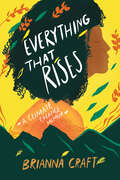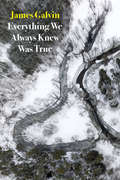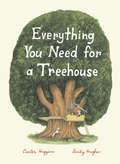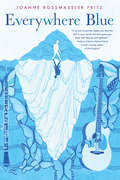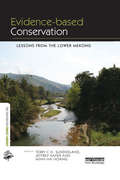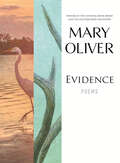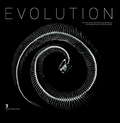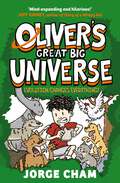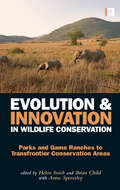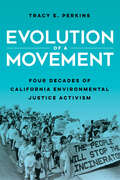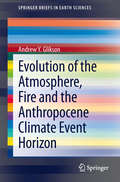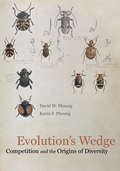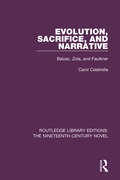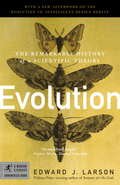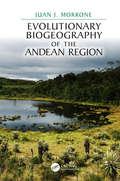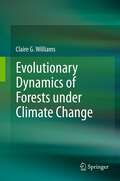- Table View
- List View
Everything That Rises: A Climate Change Memoir
by Brianna CraftOne of Ms. magazine's "Most Anticipated Feminist Books of 2023"Authentic and inspiring, Everything That Rises personalizes the realities of climate change by paralleling our relationship to the planet with the way we interact within our own homes. Nineteen-year-old Brianna Craft is having a panic attack. A professor's matter-of-fact explanation of the phenomenon known as "climate change" has her white-knuckling the table in her first environmental studies lecture. Out of her father's house, she was supposed to be safe. This moment changed everything for Brianna. For her first internship, she jumped at the chance to assist the Least Developed Countries Group at the United Nations' negotiations meant to produce a new climate treaty. While working for those most ignored yet most impacted by the climate crisis, she grappled with the negligent indifference of those who hold the most power. This dynamic painfully reminded her of growing up in a house where the loudest voice always won and violence silenced those in need. Four years later, Brianna witnessed the adoption of the first universal climate treaty, the Paris Agreement. In this memoir that blends the political with the personal, Brianna dives into what it means to advocate for the future, and for the people and places you love, all while ensuring your own voice doesn't get lost in the process. It will take all of us to protect our home.
Everything Under the Sun
by David Suzuki Ian HaningtonIn this compilation of David Suzuki's latest thoughts and writings, the renowned scientist, author, and broadcaster explores the myriad environmental challenges the world faces and their interconnected causes. In doing so, Suzuki shows that understanding the causes-and recognizing that everything in nature, including us, is interconnected-is crucial to restoring hope for a better future. The solutions are there, he argues; we just need the will to act together to bring about change.Everything Under the Sun delves into such provocative topics as the difference between human hunters and other predators, the lessons we must learn from the devastating earthquake and tsunami in Japan and the subsequent meltdown of the nuclear reactors, and our dependence on the sun for all of our food and energy-indeed for our very lives. Suzuki also considers the many positive steps people are making today. And he doesn't shy away from controversial opinion, especially when it comes to taking on those who stand in the way of resolving serious issues like climate change.Underpinning it all is the recognition that we are blessed to live on a planet that gives us everything we require to live, under a sun that gives us the energy we need to produce food and transport and modern conveniences. But we must protect what we have if we want to survive and prosper.
Everything Volcanoes and Earthquakes (National Geographic Kids Everything)
by Kathy Furgang Carsten PeterNational Geographic Kids Everything Volcanoes and Earthquakes explodes with incredible photos and amazing facts about the awesome powers of nature. <P><P>You'll find out that three-quarters of Earth's volcanoes are underwater, that an earthquake in Chile shortened the day by 1.26 milliseconds, and much more. <P><P>Bursting with fascinating information about the biggest volcanic eruptions and earth-shattering earthquakes, this book takes a fun approach to science, introducing kids to plate tectonics and the tumultuous forces brewing beneath the Earth's surface.
Everything We Always Knew Was True
by James Galvin"James Galvin has a voice and a world, perhaps the two most difficult things to achieve in poetry."-The Nation "Bleak and unsentimental but blessedly free of self-indulgence, these poems give the feeling of being absolutely essential."-Library Journal"Galvin [has] the virtues of precise observation and original language . . . a rigor of mind and firmness of phrasing which make [each] poem an architectural pleasure."-Harvard ReviewIn his first collection in seven years, James Galvin expands upon his signature spare and gnomic lyric as he engages restrained astonishment, desire, and loss in a confessional voice. Whether considering masterpieces of painting or describing the austere landscape of his native Wyoming ranchlands, Galvin turns to highly imagistic yet intimate narratives to rain down compassion within isolation.From "On the Sadness of Wedding Dresses":On starless, windless nights like thisI imagineI can hear the wedding dressesWeeping in their closets,Luminescent with hopeless longing,Like hollow angels.They know they will never be worn again.Who wants them now,After their one heroic day in the limelight?Yet they glow with desireIn the darkness of closets.James Galvin passionately depicts the rural American West and the interactions between humans and nature in his best-selling memoir The Meadow and his novel Fencing the Sky. Galvin is also the author of several volumes of poetry and teaches at the Iowa Writers' Workshop. He divides his time between Iowa and Wyoming.
Everything You Need for a Treehouse
by Emily Hughes Carter HigginsFeaturing beautiful images and a lyrical text with an exquisitely readable cadence, this book gives life and meaning to all the requisite elements of a treehouse, from time, timber, and rafters to ropes of twisted twine that invite visitors to sprawl out on a limb and slide back down again. For anyone who's ever wanted to escape real life and live in a nostalgic dream come true, this poignant picture book captures the universal timelessness of treehouses and celebrates all the creativity and adventure they spark.
Everything You Need to Ace Biology in One Big Fat Notebook (Big Fat Notebooks)
by Matthew Brown Workman PublishingThe Big Fat Notebooks go to high school! This study guide for high school Biology introduces students to all the big ideas in the course, with clear diagrams, fun doodles, clever mnemonics, and other ways to understand and remember what you need to ace this challenging course.
Everything for Sale: The Virtues and Limits of Markets
by Robert KuttnerThere's a battle raging inside and outside the halls of Congress for the economic hearts and minds of America. "Reduce the size of big government! Less regulation! Privatization! Market economy!"
Everywhere Blue
by Joanne Rossmassler FritzA brother's disappearance turns one family upside down, revealing painful secrets that threaten the life they've always known. When twelve-year-old Maddie's older brother vanishes from his college campus, her carefully ordered world falls apart. Nothing will fill the void of her beloved oldest sibling. Meanwhile Maddie's older sister reacts by staying out late, and her parents are always distracted by the search for Strum. Drowning in grief and confusion, the family's musical household falls silent. Though Maddie is the youngest, she knows Strum better than anyone. He used to confide in her, sharing his fears about the climate crisis and their planet's future. So, Maddie starts looking for clues: Was Strum unhappy? Were the arguments with their dad getting worse? Or could his disappearance have something to do with those endangered butterflies he loved . . .Scared and on her own, Maddie picks up the pieces of her family's fractured lives. Maybe her parents aren't who she thought they were. Maybe her nervous thoughts and compulsive counting mean she needs help. And maybe finding Strum won't solve everything--but she knows he's out there, and she has to try. This powerful debut novel in verse addresses the climate crisis, intergenerational discourse, and mental illness in an accessible, hopeful way. With a gorgeous narrative voice, Everywhere Blue is perfect for fans of Eventown and OCDaniel.
Evidence-based Conservation: Lessons from the Lower Mekong (The Earthscan Forest Library)
by Terry C.H. Sunderland Jeffrey Sayer Minh-Ha HoangThere is a considerable gap between the science of conservation biology and the design and execution of biodiversity conservation projects in the field. Science is often failing to inform the practice of conservation, which remains largely experience-based. The main reason is the poor accessibility of evidence on the effectiveness of different interventions. This is the basis for this book adopting an 'evidence-based approach', modelled on the systematic reviews used in health sciences and now being applied to many policy arenas. Evidence-based Conservation brings together a series of case studies, written by field practitioners, that provides the evidence-base for evaluating how effective conservation and poverty alleviation strategies can be better implemented. A series of systematic reviews uses experiences and data from fifteen integrated conservation and development projects conducted in the Lower Mekong region, specifically in Vietnam, Laos and Cambodia. They provide wide-ranging overviews of the effectiveness of protected areas and how innovative tools and methods for monitoring and evaluation can be utilised for more effective outcomes. Results are in the form of management and policy recommendations, based on the quality of evidence and the cost-utility of the intervention. By bridging the gap between field practice and conservation, the analysis should lead to more effective integrated conservation and development interventions. The book represents one of the first attempts to apply the evidence-based approach to conservation and development.
Evidence: Poems
by Mary OliverNever afraid to shed the pretense of academic poetry, never shy of letting the power of an image lie in unadorned language, Mary Oliver offers us poems of arresting beauty that reflect on the power of love and the great gifts of the natural world. Inspired by the familiar lines from William Wordsworth, "To me the meanest flower that blows can give / Thoughts that do often lie too deep for tears," she uncovers the evidence presented to us daily by nature, in rivers and stones, willows and field corn, the mockingbird's "embellishments," or the last hours of darkness.
Evie and the Animals
by Matt HaigDare to be you! Evie is a girl with a special talent: she can talk to animals and hear their thoughts. But when she rescues the school rabbit and sets her free from her too-small cage, Evie lands in big trouble. She promises her dad that she’ll never talk to animals again. And for a whole year, Evie ignores them all. She doesn’t chat to the birds and dogs. She even ignores a little ginger tabby cat who meows “Help me! Help me!” But when missing posters for cats, dogs, hamsters and tortoises appear outside school, Evie is determined to find the animals using her magical gift. With the help of Granny Flora, she must discover who is behind the disappearances. Can Evie save the pets before it’s too late—even if it means the most frightening thing of all, daring to be herself? Featuring illustrations by the award-winning Emily Gravett, this is a story about growing up, fitting in and listening closely to our furry friends that will capture the hearts of animal lovers everywhere.
Evolution
by Linda Asher Patrick Gries Jean-Baptiste De PanafieuUnprecedented in its approach, the number and diversity of the species presented, and the quality of the photographs, Evolution is the book on how we came to be what we are. Spectacular, mysterious, elegant, or grotesque, the skeletons of the vertebrates that inhabit the earth today carry within them the imprint of an evolutionary process that has lasted several billion years. This book is the result of a dual approach, scientific as well as aesthetic, rigorous yet accessible. Each chapter is made up of a short text that illuminates one theme of the evolutionary process--repetition, adaptation, polymorphism, sexual selection, and more--and a series of exquisitely composed photographs of skeletons against a black background. Approximately three hundred photographs of whole skeletons or their details have been made possible by the French National Museum of Natural History. The reader learns, by experiencing each text and photograph together, how the structure of every creature has been shaped by its environmental and genetic inheritance.
Evolution Changes Everything! (Oliver's Great Big Universe)
by Jorge Cham&‘Mind-expanding and hilarious!&’ Jeff Kinney, author of the bestselling DIARY OF A WIMPY KID series.The third book in the hilarious series that makes you laugh-out-loud AND grows your brain. Perfect for readers age 8+ and fans of Diary of a Wimpy Kid and The 13-Storey Treehouse. Hi, I&’m Oliver! My next book is about something everyone loves – animals! It has to be the best one yet if I&’m going sell enough copies to finally buy a computer than doesn&’t majorly lag. Of course I still have to deal with all the usual stuff: neighbourhood chores, gaming problems, and a disastrous friendship group break-up. But all this thinking about how animals evolved has got me wondering about where we came from, and all things about: how scum and bacteria are the origins of life Mass extinctions and what happened to the dinosaurs Fish, dogs, horses, chickens. And oh yes, people! From bestselling writer and robotics engineer Jorge Cham, Oliver&’s Great Big Universe: Evolution Changes Everything! is the third book in a STEM-themed, diary-style series.
Evolution and Innovation in Wildlife Conservation: Parks and Game Ranches to Transfrontier Conservation Areas
by Brian Child Helen Suich Spenceley AnnaThe crucible of innovation in wildlife and habitat conservation is in southern Africa where it has co-evolved with decolonization, political transformation and the rise of development, ownership, management and livelihood debates. Charting this innovation, early chapters deal with the traditional 'fines and fences' conservation that occurred in the colonial and early post-independence period, with subsequent sections focussing on the experimentation and innovation that occurred on private and communal land as a result of the break from these traditional methods. The final section deals with more recent innovations in the sector, focussing on building and strengthening the relationships between parks and society. Importantly, the book provides a data-rich summary of experimentation with more inclusive models of conservation in terms of ecological, social, political and economic indicators. Published with the Southern African Sustainable Use Specialist Group (SASUSG) of IUCN
Evolution from a Thermodynamic Perspective: Implications for Species Conservation and Agricultural Sustainability
by Carl F JordanSurvival of the fittest” is a tautology, because those that are “fit” are the ones that survive, but to survive, a species must be “fit”. Modern evolutionary theory avoids the problem by defining fitness as reproductive success, but the complexity of life that we see today could not have evolved based on selection that favors only reproductive ability. There is nothing inherent in reproductive success alone that could result in higher forms of life. Evolution from a Thermodynamic Perspective presents a non-circular definition of fitness and a thermodynamic definition of evolution. Fitness means maximization of power output, necessary to survive in a competitive world. Evolution is the “storage of entropy”. “Entropy storage” means that solar energy, instead of dissipating as heat in the Earth, is stored in the structure of living organisms and ecosystems. Part one explains this in terms comprehensible to a scientific audience beyond biophysicists and ecosystem modelers. Part two applies thermodynamic theory in non-esoteric language to sustainability of agriculture, and to conservation of endangered species. While natural systems are stabilized by feedback, agricultural systems remain in a mode of perpetual growth, pressured by balance of trade and by a swelling population. The constraints imposed by thermodynamic laws are being increasingly felt as economic expansion destabilizes resource systems on which expansion depends.
Evolution from the Galapagos: Two Centuries after Darwin
by Carlos Montúfar Gabriel TruebaThis volume is a collection of the some of the most significant lectures that well-known experts presented at our two international "summits on evolution" (2005, 2009) as updated and revised chapters. The meetings took place on one of the large islands of the Galapagos archipelago (San Cristobal) at GAIAS (Galapagos Institute for the Arts and Sciences) of the Universidad San Francisco de Quito (USFQ), Ecuador. The main goal of the two Galapagos Summits on Evolution has been to bring together scientists and graduate students engaged in the study of evolution, from life's origin to its current diversity. Because of their historical significance, the Galapagos are a unique venue for promoting comprehensive research on evolution and ecology and to make the research results available to students and teachers everywhere, but especially from developing countries. As shown by the enthusiastic attendance at both summits and the many suggestions to keep them continuing, the meetings have opened new opportunities for students from Ecuador and other Latin American countries to be inspired by some of the most brilliant minds in evolutionary science.
Evolution of International Environmental Regimes
by Simone SchieleDrawing specifically on the international climate regime, Simone Schiele examines international environmental regimes from a legal perspective and analyses a core feature of international regimes – their ability to evolve over time. In particular, she develops a theoretical framework based on general international law which allows for a thorough examination of the understanding of international law and the options for law-creation in international environmental regimes. The analysis therefore provides both a coherent understanding of the international climate regime and a starting point for further research in other regimes.
Evolution of a Movement: Four Decades of California Environmental Justice Activism
by Tracy E. PerkinsDespite living and working in California, one of the county's most environmentally progressive states, environmental justice activists have spent decades fighting for clean air to breathe, clean water to drink, and safe, healthy communities. Evolution of a Movement tells their story—from the often-raucous protests of the 1980s and 1990s to activists' growing presence inside the halls of the state capitol in the 2000s and 2010s. Tracy E. Perkins traces how shifting political contexts combined with activists' own efforts to institutionalize their work within nonprofits and state structures. By revealing these struggles and transformations, Perkins offers a new lens for understanding environmental justice activism in California. Drawing on case studies and 125 interviews with activists from Sacramento to the California-Mexico border, Perkins explores the successes and failures of the environmental justice movement in California. She shows why some activists have moved away from the disruptive "outsider" political tactics common in the movement's early days and embraced traditional political channels of policy advocacy, electoral politics, and working from within the state's political system to enact change. Although some see these changes as a sign of the growing sophistication of the environmental justice movement, others point to the potential of such changes to blunt grassroots power. At a time when environmental justice scholars and activists face pressing questions about the best route for effecting meaningful change, this book provides insight into the strengths and limitations of social movement institutionalization.
Evolution of the Atmosphere, Fire and the Anthropocene Climate Event Horizon
by Andrew Y. GliksonUnique among all creatures, further to the increase in its cranial volume from Australopithecus to Homo sapiens, the use of tools and cultural and scientific creativity, the genus Homo is distinguished by the mastery of fire, which since about two million years ago has become its blueprint. Through the Holocene and culminating in the Anthropocene, the burning of much of the terrestrial vegetation, excavation and combustion of fossil carbon from up to 420 million years-old biospheres, are leading to a global oxidation event on a geological scale, a rise in entropy in nature and the sixth mass extinction of species.
Evolution's Wedge
by Karin S. Pfennig David W. PfennigEvolutionary biology has long sought to explain how new traits and new species arise. Darwin maintained that competition is key to understanding this biodiversity and held that selection acting to minimize competition causes competitors to become increasingly different, thereby promoting new traits and new species. Despite Darwin's emphasis, competition's role in diversification remains controversial and largely underappreciated. In their synthetic and provocative book, evolutionary ecologists David and Karin Pfennig explore competition's role in generating and maintaining biodiversity. The authors discuss how selection can lessen resource competition or costly reproductive interactions by promoting trait evolution through a process known as character displacement. They further describe character displacement's underlying genetic and developmental mechanisms. The authors then consider character displacement's myriad downstream effects, ranging from shaping ecological communities to promoting new traits and new species and even fueling large-scale evolutionary trends. Drawing on numerous studies from natural populations, and written for a broad audience, Evolution's Wedge seeks to inspire future research into character displacement's many implications for ecology and evolution.
Evolution, Development and Ecology of Anemonefishes: Model Organisms for Marine Science
by Vincent Laudet and Timothy RavasiAnemonefishes, one of the most popular and recognizable of fishes in the world, are much more than film characters; they are also emerging model organisms for studying the biology, ecology, and evolution of coral reef fishes. They are a group of 28 species often employed to study patterns and processes of social organization, intra- and inter-specific competition, sex change, mutualism, dispersal and connectivity of fish populations, habitat selection, pigment pattern formation, lifespan and predator-prey interactions. This multi-authored book covers all these areas and provides an update on the research done with this model and the perspective it opens for the future. Key Features Contains basic and up-to-date information on an emerging fish model Allows non-specialist readers to grasp the relevance of a wide research area Provides accurate and easy to access information on each of the 28 species Includes guidance for establishing a breeding colony Documents that anemonefishes are useful model organisms for ecological, developmental and climate research The Open Access version of this book, available at www.taylorfrancis.com, has been made available under a Creative Commons Attribution-Non Commercial-No Derivatives 4.0 license.
Evolution, Sacrifice, and Narrative: Balzac, Zola, and Faulkner (Routledge Library Editions: The Nineteenth-Century Novel #7)
by Carol ColatrellaFirst published in 1990. Balzac, Zola and Faulkner all drew upon the principles of evolutionary theory to represent man’s place in nature and his struggle for survival in their major series La Comèdie humaine, Rougon-Macquart and the Yoknapatawpha fiction. This book focuses on the ‘first’ novels in each author’s series (La Père Goriot, La Fortune des Rougon and Flags in the Dust) and considers how each novel relates to its series and derives a definition of the naturalistic roman-fleuve. To describe this development, the issues of how a scientific idea becomes refracted in a literary genre and how the naturalistic novel developed out of the realistic novel are considered.
Evolution: The Remarkable History of a Scientific Theory (Modern Library Chronicles)
by Edward J. Larson"I often said before starting, that I had no doubt I should frequently repent of the whole undertaking." So wrote Charles Darwin aboard The Beagle, bound for the Galapagos Islands and what would arguably become the greatest and most controversial discovery in scientific history. But the theory of evolution did not spring full-blown from the head of Darwin. Since the dawn of humanity, priests, philosophers, and scientists have debated the origin and development of life on earth, and with modern science, that debate shifted into high gear.In this lively, deeply erudite work, Pulitzer Prize-winning science historian Edward J. Larson takes us on a guided tour of Darwin's "dangerous idea," from its theoretical antecedents in the early nineteenth century to the brilliant breakthroughs of Darwin and Wallace, to Watson and Crick's stunning discovery of the DNA double helix, and to the triumphant neo-Darwinian synthesis and rising sociobiology today.Along the way, Larson expertly places the scientific upheaval of evolution in cultural perspective: the social and philosophical earthquake that was the French Revolution; the development, in England, of a laissez-faire capitalism in tune with a Darwinian ethos of "survival of the fittest"; the emergence of Social Darwinism and the dark science of eugenics against a backdrop of industrial revolution; the American Christian backlash against evolutionism that culminated in the famous Scopes trial; and on to today's world, where religious fundamentalists litigate for the right to teach "creation science" alongside evolution in U.S. public schools, even as the theory itself continues to evolve in new and surprising directions.Throughout, Larson trains his spotlight on the lives and careers of the scientists, explorers, and eccentrics whose collaborations and competitions have driven the theory of evolution forward. Here are portraits of Cuvier, Lamarck, Darwin, Wallace, Haeckel, Galton, Huxley, Mendel, Morgan, Fisher, Dobzhansky, Watson and Crick, W. D. Hamilton, E. O. Wilson, and many others. Celebrated as one of mankind's crowning scientific achievements and reviled as a threat to our deepest values, the theory of evolution has utterly transformed our view of life, religion, origins, and the theory itself, and remains controversial, especially in the United States (where 90% of adults do not subscribe to the full Darwinian vision). Replete with fresh material and new insights, Evolution will educate and inform while taking readers on a fascinating journey of discovery.From the Hardcover edition.
Evolutionary Biogeography of the Andean Region (CRC Biogeography Series)
by Juan J. MorroneKey features: The first reference book to provide a comprehensive treatment of the biogreography of the Andean region Includes lists of the synonyms for each area and examples of the plant and animal taxa characterizing them. An extensive reference section serves as an entry point for more in-depth research on individual subjects Discusses the relationships between the areas, formulating hypotheses explaining the relationships of different biotas, based on track and cladistic biogeographic analyses Identifies cenocrons that were assembled in the different biotas Contains maps that illustrate the distribution of particular taxa, area cladograms and vegetation profiles This book presents a regionalization of the Andean region, based on an evolutionary biogeographic approach. Aimed at anyone wishing to understand biogeographic patterns of distribution of Andean plants and animals, the book provides a comprehensive treatment of three subregions, one transition zone, and 16 provinces. Lists of the synonyms and examples of taxa characterizing each area are given, and the relationships between the areas discussed, alongside hypotheses explaining the assembly of different biotas. Several maps illustrate the distribution of particular taxa, as well as area cladograms, diagrams and full-color vegetation profiles.
Evolutionary Dynamics of Forests under Climate Change
by Claire G. WilliamsFocusing on the example of the Lost Pines forest of Texas, this book contextualises the present-day conservation of the Lost Pines within its wealth of historical and geological records. This in turn presents a realistic example for examining evolutionary dynamics models and how they can guide management of temperate pine forests under the uncertainty of future climate change. Synthesising knowledge from many scholarly disciplines, and presenting the latest knowledge on how temperate forests respond to climate change, the book provides insight into how resource professionals actually solve complex multi-layered problems. A useful aid for forest management professionals and for advanced students and professionals in ecology, the book is a valuable resource for researchers and professionals, which can also be used as a classroom exercise for spatial imaging, testing virtual simulations and developing field-based research questions.
